A Game-Theoretic Approach of Optimized Operation of AC/DC Hybrid Microgrid Clusters
Abstract
:1. Introduction
- (1)
- This paper proposes a novel potential game to achieve the optimized operation of AC/DC microgrid clusters. The benefit losses caused by multiple microgrids in the competition are reduced to a significantly low level. The existence and convergence of the Nash equilibrium of the proposed strict potential game have been proven.
- (2)
- This paper introduces a new interlinking bidirectional AC/DC converter unit in the modeling of the microgrid.
- (3)
- A new multiple objective optimization function has been introduced, which incorporates fuel cost, environmental cost, equipment maintenance cost, the transaction cost, and the equivalent cost of power loss in the interlinking converters.
- (4)
- Based on the supply and demand theory, the dynamic adjustment mechanism of electricity price is introduced into microgrid clusters.
- (5)
- The proposed potential game approach can transform the multivariate multi-objective optimization process into a process of finding the extreme value of the potential function, which simplifies the algorithm compared with Ref. [17].
2. Mathematical Model of AC/DC Hybrid Microgrid
2.1. Mathematical Models of Distributed Units
2.2. Mathematical Model of the AC/DC Hybrid Microgrid
2.3. Optimized Revenue Function for Microgrids Based on Supply and Demand Theory
3. Optimal Operation of AC/DC Microgrid Cluster Based on Potential Game Theory
3.1. Non-Cooperative Game Model for Optimal Operation of Microgrid Clusters
3.2. Proof of Existence of Nash Equilibrium Solution of Non-Cooperative Game Model
3.3. Solving Method for Nash Equilibrium Solution of Non-Cooperative Game Model
| Algorithm 1: Pseudocode of solving proposed game |
| Inputs: PFC,max, PFC,min, PMT,max, PMT,min, Pbat,ac,max, Pbat,dc,max, ηbat,ac, ηbat,dc, cbat,ac, cbat,dc, a0(t), b(t), PPV(t), PWT(t), PLoad(t), PPV,max, PWT,max, EESS,max; Outputs: (, , ); 1. Decide random initial value: {PPV, PWT, PMT, PFC, PMG, Pbat,ac, Pbat,dc}∈{SMG1, SMG2, SMG3}; 2. Calculate: UMG1, UMG2, UMG3 while (, , ) ≠ (, , ) 3. = UMG1(, , ); 4. = UMG2(, , ); 5. = UMG3(, , ); end while 6. Decide: (, , ) = (, , ); |
3.4. Verify the Efficiency of the Nash Equilibrium State
4. Case Studies and Discussion
5. Conclusions
Author Contributions
Funding
Institutional Review Board Statement
Informed Consent Statement
Data Availability Statement
Conflicts of Interest
Abbreviations
| MMC | Modular Multilevel Converter |
| AC | Alternating Current |
| DC | Direct Current |
| AC/DC | Alternating Current to Direct Current |
| PV | Photovoltaic |
| WT | Wind Turbine |
| ESS | Energy Storage System |
| MT | Micro-gas Turbine |
| FC | Fuel Cell |
| SOC | State of Charge |
| Pos | Price of stability |
References
- Kakigano, H.; Miura, Y.; Ise, T.; Uchida, R. DC micro-grid for super high quality distribution—System configuration and control of distributed generations and energy storage devices. In Proceedings of the 2006 37th IEEE Power Electronics Specialists Conference, Jeju, Korea, 18–22 June 2006; pp. 1–7. [Google Scholar]
- Ram, R.; Rao, M.V.G. Operation and Control of Grid Connected Hybrid AC/DC Microgrid using Various RES. Int. J. Appl. Eng. Res. 2014, 5, 195–202. [Google Scholar]
- Khezri, R.; Mahmoudi, A. Review on the state-of-the-art multi-objective optimisation of hybrid standalone/grid-connected energy systems. IET Gener. Transm. Distrib. 2020, 14, 4285–4300. [Google Scholar] [CrossRef]
- Gregoratti, D.; Matamoros, J. Distributed Energy Trading: The Multiple-Microgrid Case. IEEE Trans. Ind. Electron. 2015, 62, 2551–2559. [Google Scholar] [CrossRef] [Green Version]
- Lee, J.; Guo, J.; Choi, J.K.; Zukerman, M. Distributed Energy Trading in Microgrids: A Game-Theoretic Model and Its Equilibrium Analysis. IEEE Trans. Ind. Electron. 2015, 62, 3524–3533. [Google Scholar] [CrossRef]
- Bui, V.H.; Hussain, A.; Im, Y.H.; Kim, H.M. An internal trading strategy for optimal energy management of combined cooling, heat and power in building microgrids. Appl. Energy 2019, 239, 536–548. [Google Scholar] [CrossRef]
- Zhang, B.; Li, Q.; Wang, L.; Feng, W. Robust optimization for energy transactions in multi-microgrids under uncertainty. Appl. Energy 2018, 217, 346–360. [Google Scholar] [CrossRef]
- Liu, Y.; Guo, L.; Wang, C. A robust operation-based scheduling optimization for smart distribution networks with multi-microgrids. Appl. Energy 2018, 228, 130–140. [Google Scholar] [CrossRef]
- Wei, C.; Fadlullah, Z.M.; Kato, N.; Takeuchi, A. GT-CFS: A Game Theoretic Coalition Formulation Strategy for Reducing Power Loss in Micro Grids. IEEE Trans. Parallel Distrib. Systs. 2014, 25, 2307–2317. [Google Scholar] [CrossRef]
- Dashti, Z.A.; Lotfi, M.M.; Mazidi, M. A Non-Cooperative Game Theoretic Model for Energy Pricing in Smart Distribution Networks Including Multiple Microgrids. In Proceedings of the 2019 27th Iranian Conference on Electrical Engineering (ICEE), Yazd, Iran, 30 April–2 May 2019; pp. 808–812. [Google Scholar]
- Dong, X.; Li, X.; Cheng, S. Energy Management Optimization of Microgrid Cluster Based on Multi-Agent-System and Hierarchical Stackelberg Game Theory. IEEE Access 2020, 8, 206183–206197. [Google Scholar] [CrossRef]
- Mondal, A.; Misra, S.; Obaidat, M.S. Distributed Home Energy Management System with Storage in Smart Grid Using Game Theory. IEEE Syst. J. 2017, 11, 1857–1866. [Google Scholar] [CrossRef]
- Park, S.; Lee, J.; Bae, S.; Hwang, G.; Choi, J.K. Contribution-Based Energy-Trading Mechanism in Microgrids for Future Smart Grid: A Game Theoretic Approach. IEEE Trans. Ind. Electron. 2016, 63, 4255–4265. [Google Scholar] [CrossRef]
- Park, S.; Lee, J.; Hwang, G.; Choi, J.K. Event-Driven Energy Trading System in Microgrids: Aperiodic Market Model Analysis with a Game Theoretic Approach. IEEE Access 2017, 5, 26291–26302. [Google Scholar] [CrossRef]
- Belgana, A.; Rimal, B.P.; Maier, M. Multi-objective pricing game among interconnected smart microgrids. In Proceedings of the 2014 IEEE PES General Meeting|Conference & Exposition, National Harbor, MD, USA, 27–31 July 2014; pp. 1–5. [Google Scholar]
- Fu, Y.; Zhang, Z.; Li, Z.; Mi, Y. Energy Management for Hybrid AC/DC Distribution System with Microgrid Clusters Using Non-Cooperative Game Theory and Robust Optimization. IEEE Trans. Smart Grid 2019, 11, 1510–1525. [Google Scholar] [CrossRef]
- Chen, L.; Niu, Y.; Jia, T. Distributed Energy Seheduling of Islanded Microgrid Based on Potential Game. In Proceedings of the 2020 Chinese Automation Congress (CAC), Shanghai, China, 6–8 November 2020; pp. 1151–1156. [Google Scholar]
- Wang, W.; Chen, K.; Bai, Y.; Chen, Y.; Wang, J. New estimation method of wind power density with three-parameter Weibull distribution: A case on Central Inner Mongolia suburbs. Wind Energy 2021, 25, 368–386. [Google Scholar] [CrossRef]
- Zhang, Y.; Jiang, J. Research on Maximum Power Point Tracking Method for Grid-Connected Photovoltaic Power Generation System. In Proceedings of the 2015 International Conference on Automation, Mechanical Control and Computational Engineering, Jinan, China, 24–26 April 2015; pp. 1905–1910. [Google Scholar]
- Liu, X.; Liu, Y. On the Determination of the Output Power in Mono/Multicrystalline Photovoltaic Cells. Int. J. Photoenergy 2021, 2021, 6692598. [Google Scholar] [CrossRef]
- Barhoumi, E.M.; Farhani, S.; Bacha, F. High efficiency power electronic converter for fuel cell system application. Ain Shams Eng. J. 2021, 12, 2655–2664. [Google Scholar] [CrossRef]
- Xu, J.; Zhu, F.; Wang, S. Comprehensive Comparison of Ultra-low Emission Coal-Fired Power Plants and Gas-Fired Power Plants. Electr. Power 2020, 53, 164–172, 179. [Google Scholar]
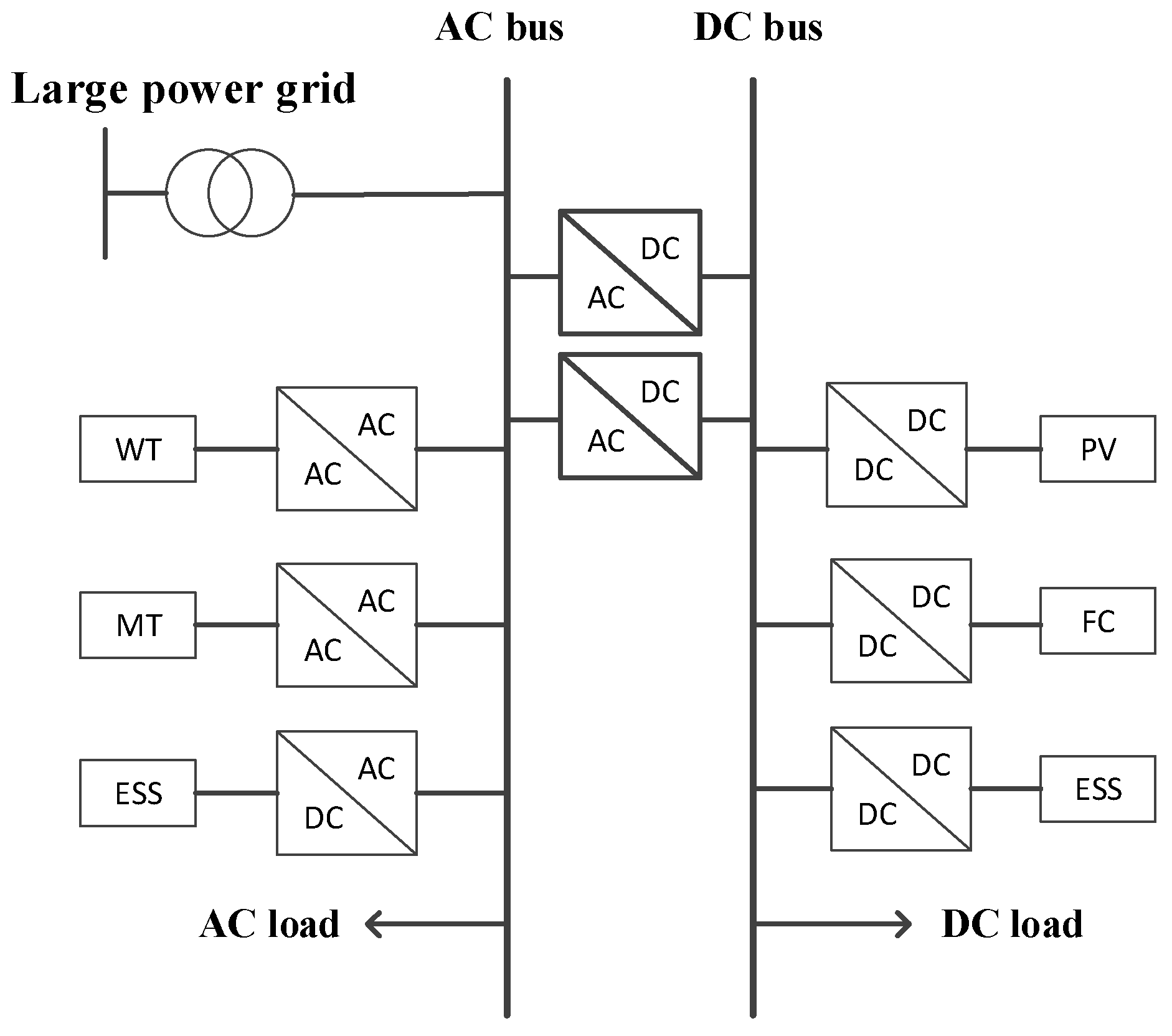
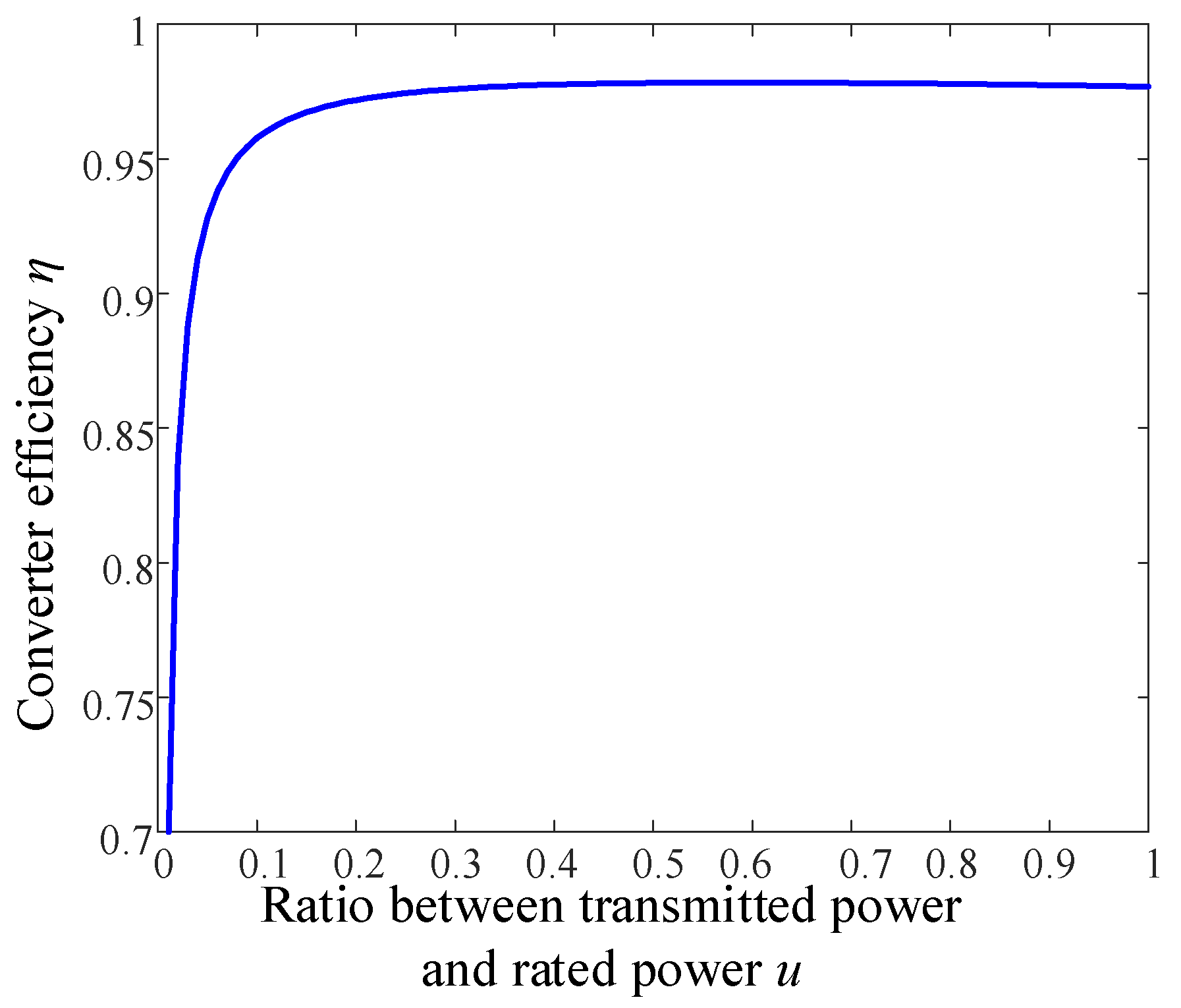
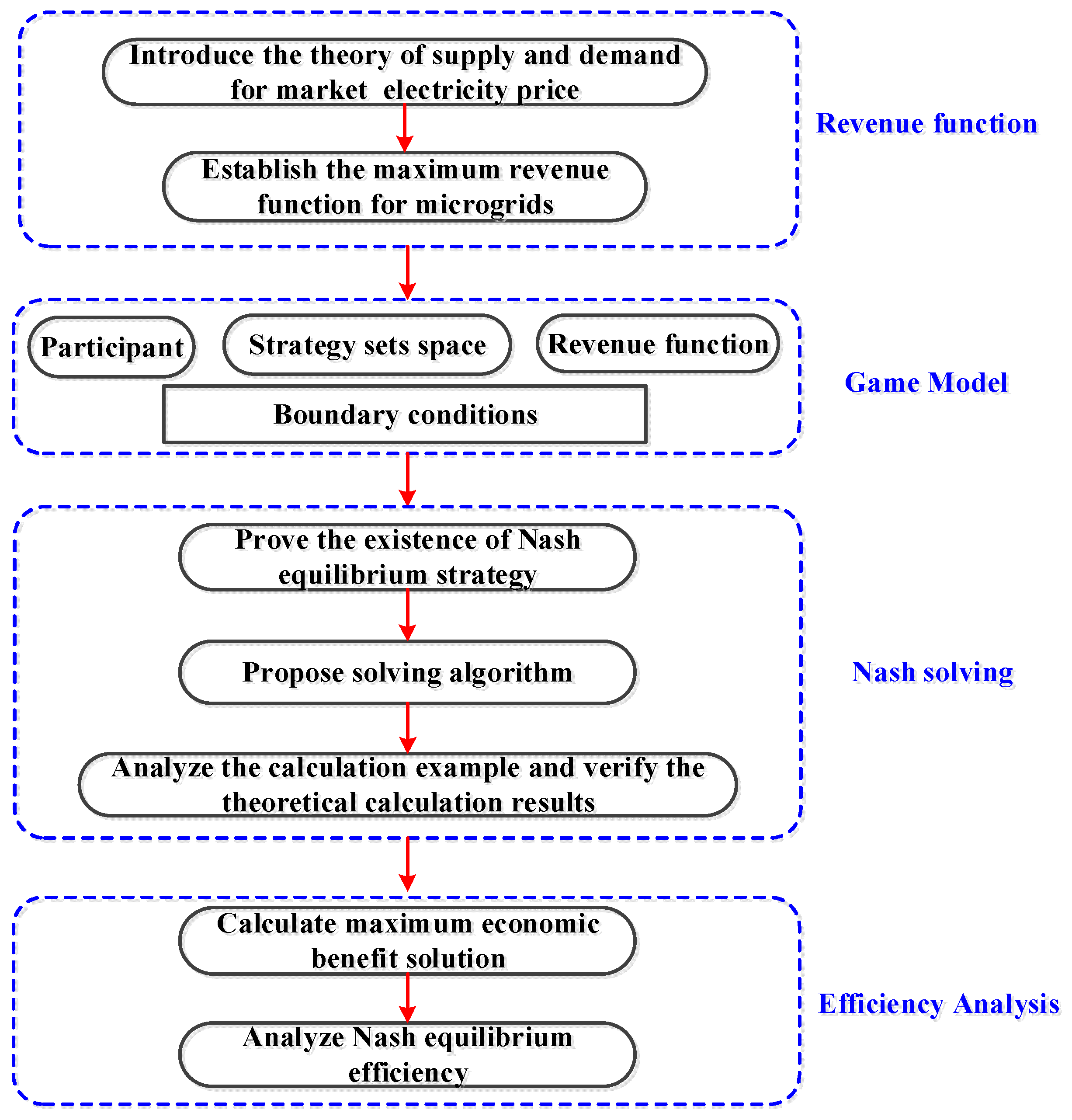
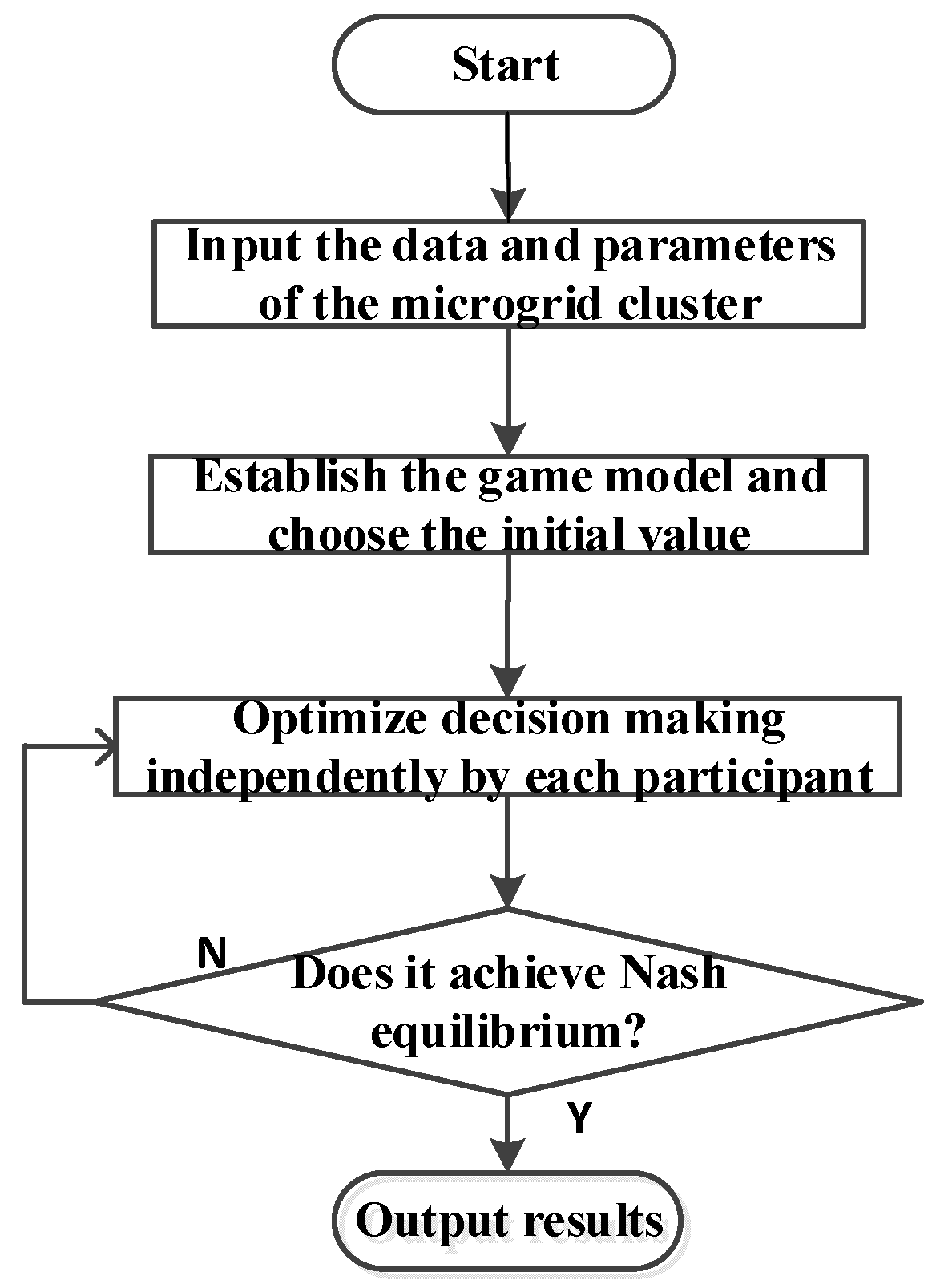



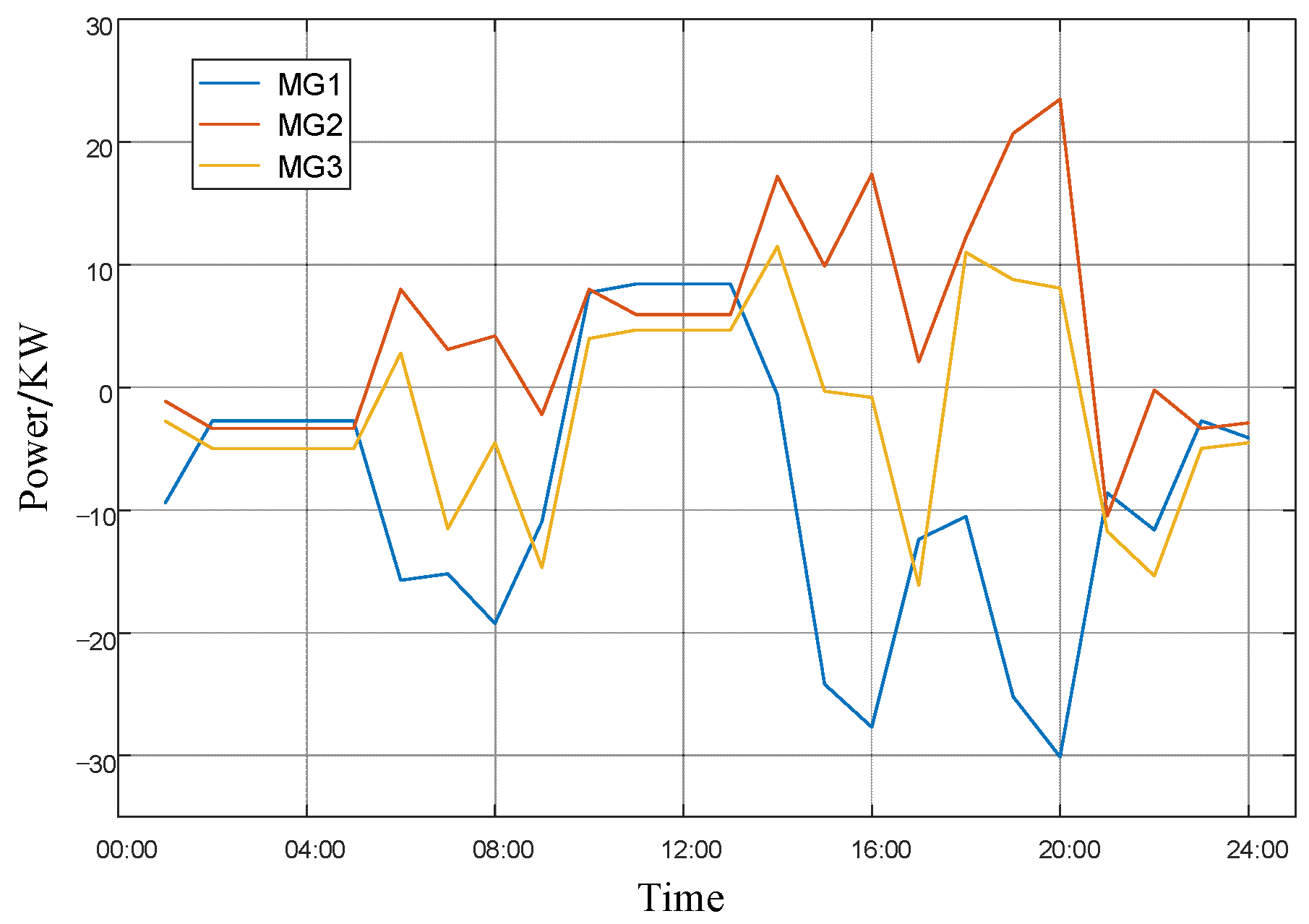


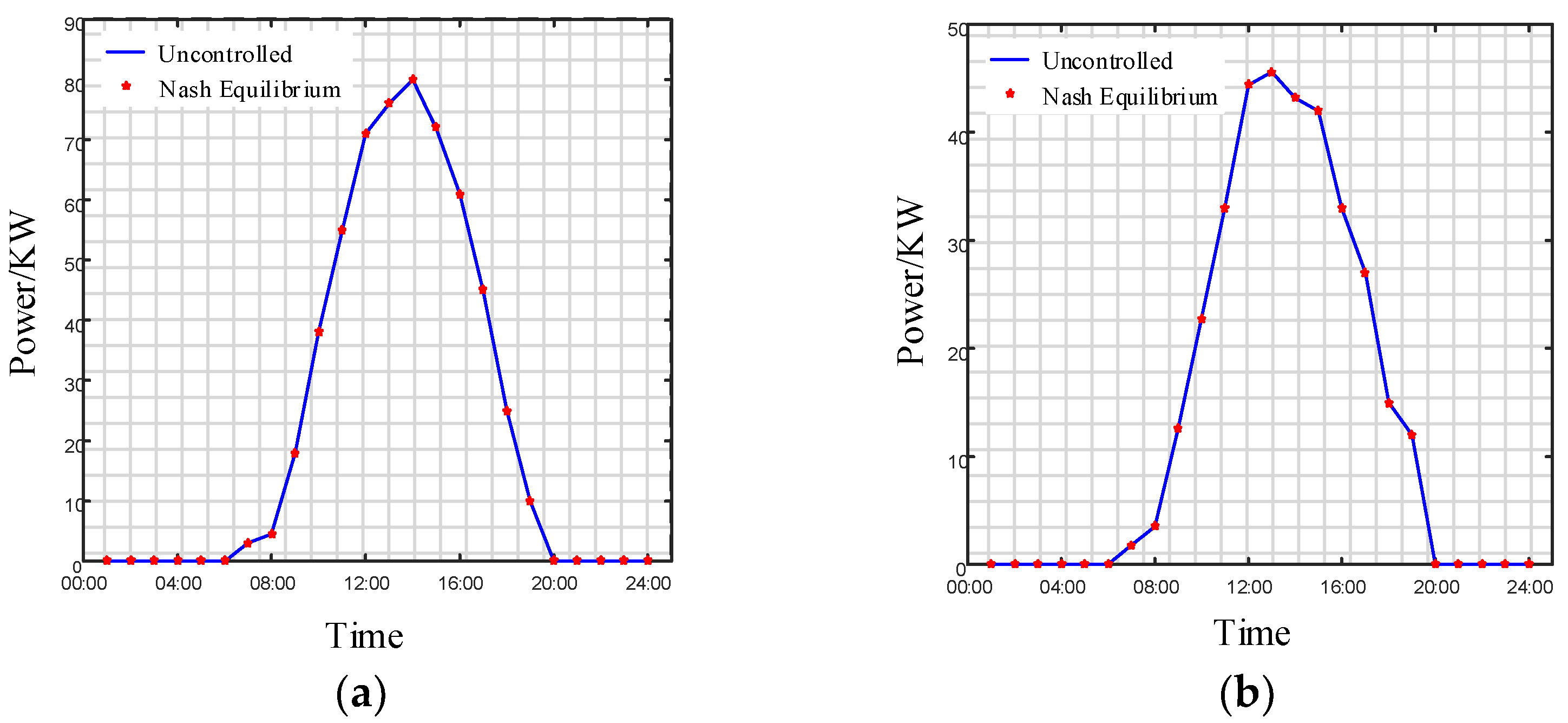
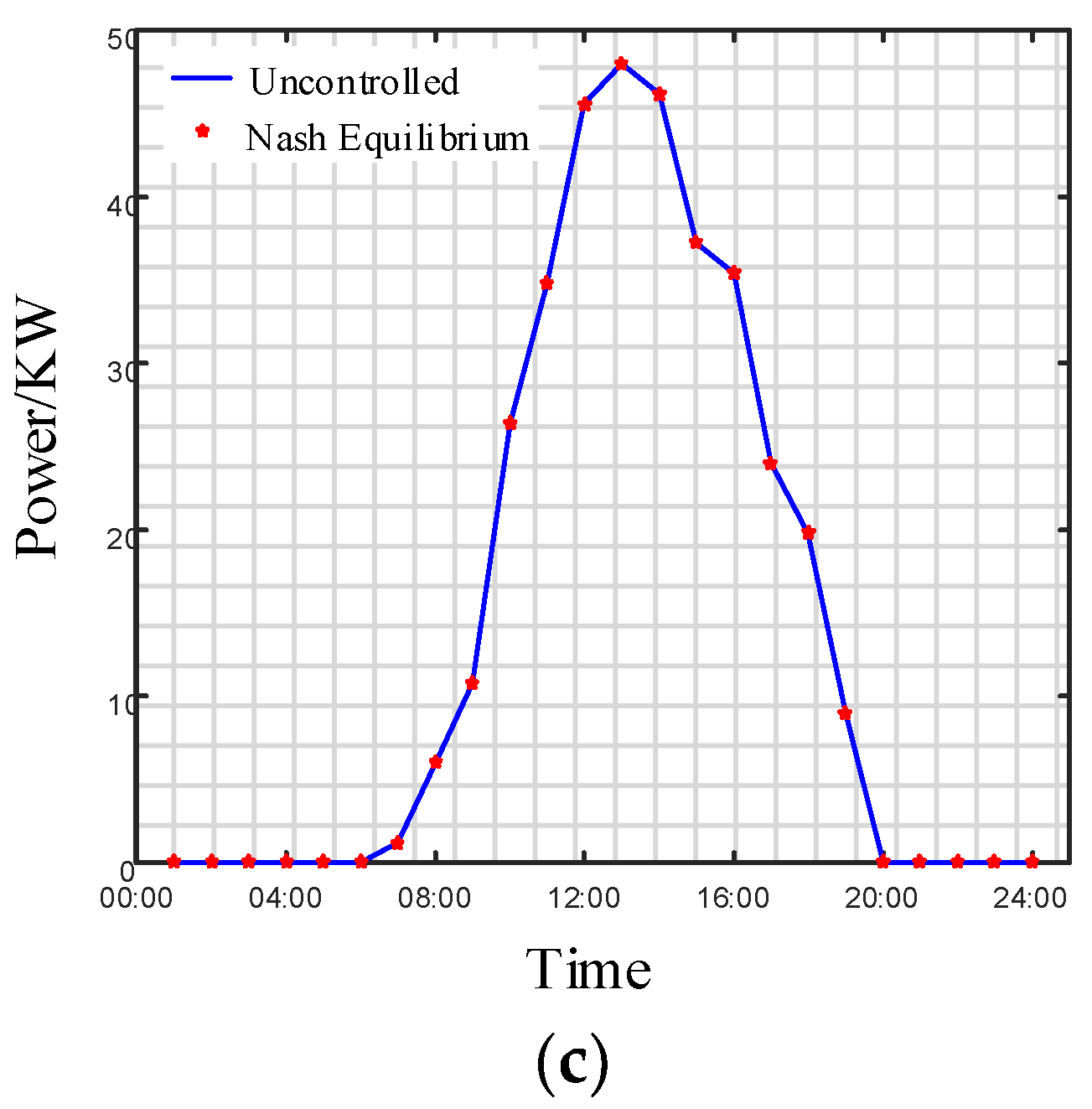

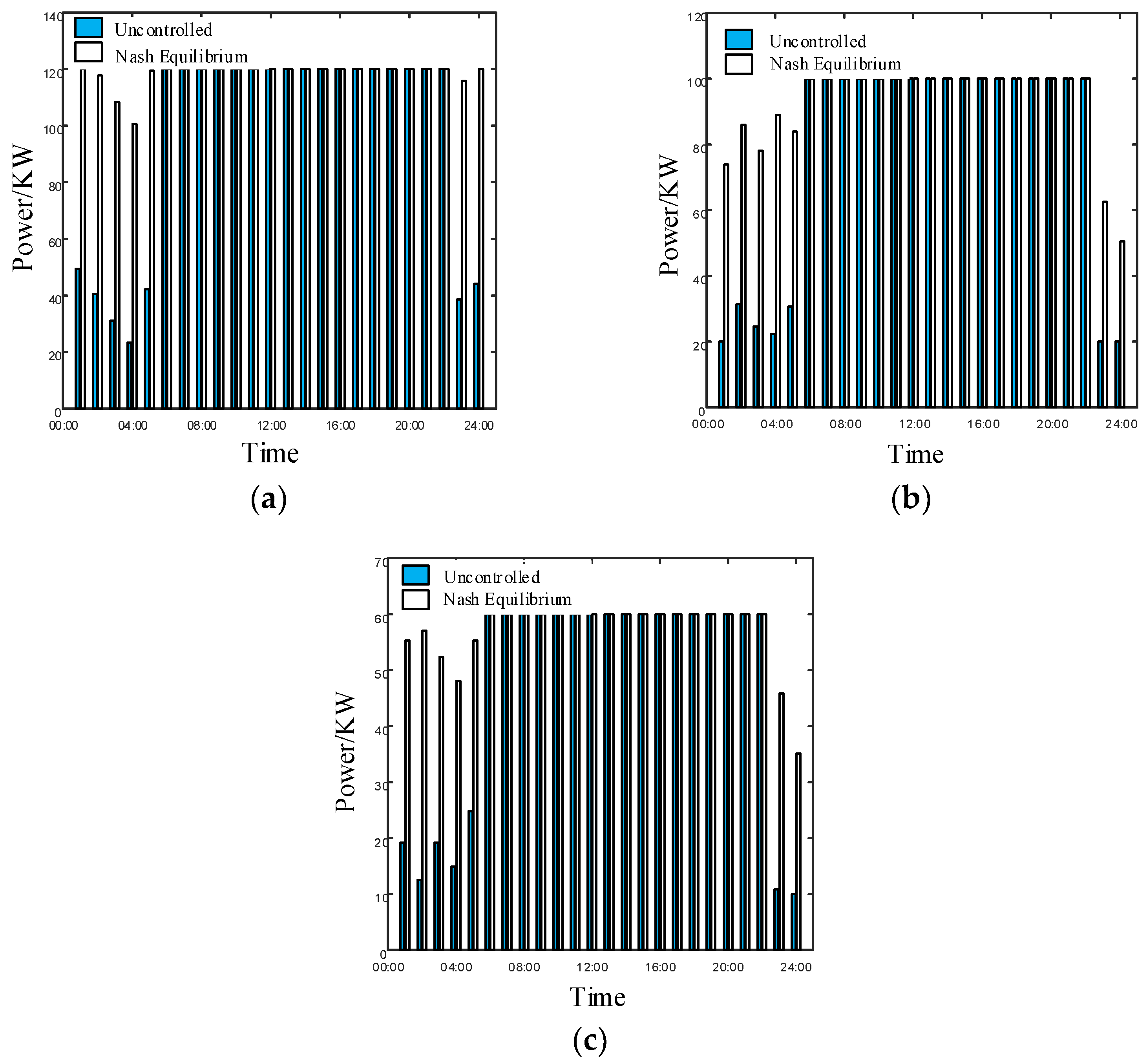

| Device Type | Maintenance Cost (CNY/kW) | Device Type | Maintenance Cost (CNY/kW) |
|---|---|---|---|
| MT | 0.03992 | PV array | 0.0096 |
| FC | 0.02849 | WT | 0.0296 |
| Generating Equipment | CO2 | NOx | SO2 |
|---|---|---|---|
| MT | 730 | 0.62 | 0.001 |
| FC | 360 | 0.25 | 0.00 |
| PV | 0.00 | 0.00 | 0.00 |
| WT | 0.00 | 0.00 | 0.00 |
| Parameter | MG1 | MG2 | MG3 |
|---|---|---|---|
| PFC,max (kW) | 120 | 100 | 60 |
| PFC,min (kW) | 20 | 20 | 10 |
| PMT,max (kW) | 130 | 100 | 65 |
| PMT,min (kW) | 20 | 10 | 10 |
| PV generation capacity (kW) | 100 | 60 | 60 |
| Wind turbine generation capacity (kW) | 100 | 60 | 60 |
| Pbat,ac,max (kW) | 20 | 20 | 20 |
| Pbat,dc,max (kW) | 20 | 20 | 20 |
| Energy storage system capacity (kW) | 100 | 100 | 100 |
| ηbat,ac | 0.95 | 0.95 | 0.95 |
| ηbat,dc | 0.95 | 0.95 | 0.95 |
| cbat,ac (CNY/kWh) | 0.15 | 0.15 | 0.15 |
| cbat,dc (CNY/kWh) | 0.15 | 0.15 | 0.15 |
| Time Period | Electricity Price (CNY/kWh) | Time Period | Electricity Price (CNY/kWh) |
|---|---|---|---|
| 1 | 0.32 | 13 | 0.95 |
| 2 | 0.32 | 14 | 0.95 |
| 3 | 0.32 | 15 | 0.63 |
| 4 | 0.32 | 16 | 0.63 |
| 5 | 0.32 | 17 | 0.63 |
| 6 | 0.63 | 18 | 0.95 |
| 7 | 0.63 | 19 | 0.95 |
| 8 | 0.63 | 20 | 0.95 |
| 9 | 0.63 | 21 | 0.63 |
| 10 | 0.95 | 22 | 0.63 |
| 11 | 0.95 | 23 | 0.32 |
| 12 | 0.95 | 24 | 0.32 |
| Price Multiplier | Pos | Price Multiplier | Pos |
|---|---|---|---|
| 0.001 | 1.0015 | 0.006 | 1.0075 |
| 0.002 | 1.0028 | 0.007 | 1.0083 |
| 0.003 | 1.0047 | 0.008 | 1.0089 |
| 0.004 | 1.0062 | 0.009 | 1.0093 |
| 0.005 | 1.007 | 0.01 | 1.0097 |
Publisher’s Note: MDPI stays neutral with regard to jurisdictional claims in published maps and institutional affiliations. |
© 2022 by the authors. Licensee MDPI, Basel, Switzerland. This article is an open access article distributed under the terms and conditions of the Creative Commons Attribution (CC BY) license (https://creativecommons.org/licenses/by/4.0/).
Share and Cite
Pan, X.; Yang, F.; Ma, P.; Xing, Y.; Zhang, J.; Cao, L. A Game-Theoretic Approach of Optimized Operation of AC/DC Hybrid Microgrid Clusters. Energies 2022, 15, 5537. https://doi.org/10.3390/en15155537
Pan X, Yang F, Ma P, Xing Y, Zhang J, Cao L. A Game-Theoretic Approach of Optimized Operation of AC/DC Hybrid Microgrid Clusters. Energies. 2022; 15(15):5537. https://doi.org/10.3390/en15155537
Chicago/Turabian StylePan, Xuewei, Fan Yang, Peiwen Ma, Yijin Xing, Jinye Zhang, and Lingling Cao. 2022. "A Game-Theoretic Approach of Optimized Operation of AC/DC Hybrid Microgrid Clusters" Energies 15, no. 15: 5537. https://doi.org/10.3390/en15155537
APA StylePan, X., Yang, F., Ma, P., Xing, Y., Zhang, J., & Cao, L. (2022). A Game-Theoretic Approach of Optimized Operation of AC/DC Hybrid Microgrid Clusters. Energies, 15(15), 5537. https://doi.org/10.3390/en15155537







